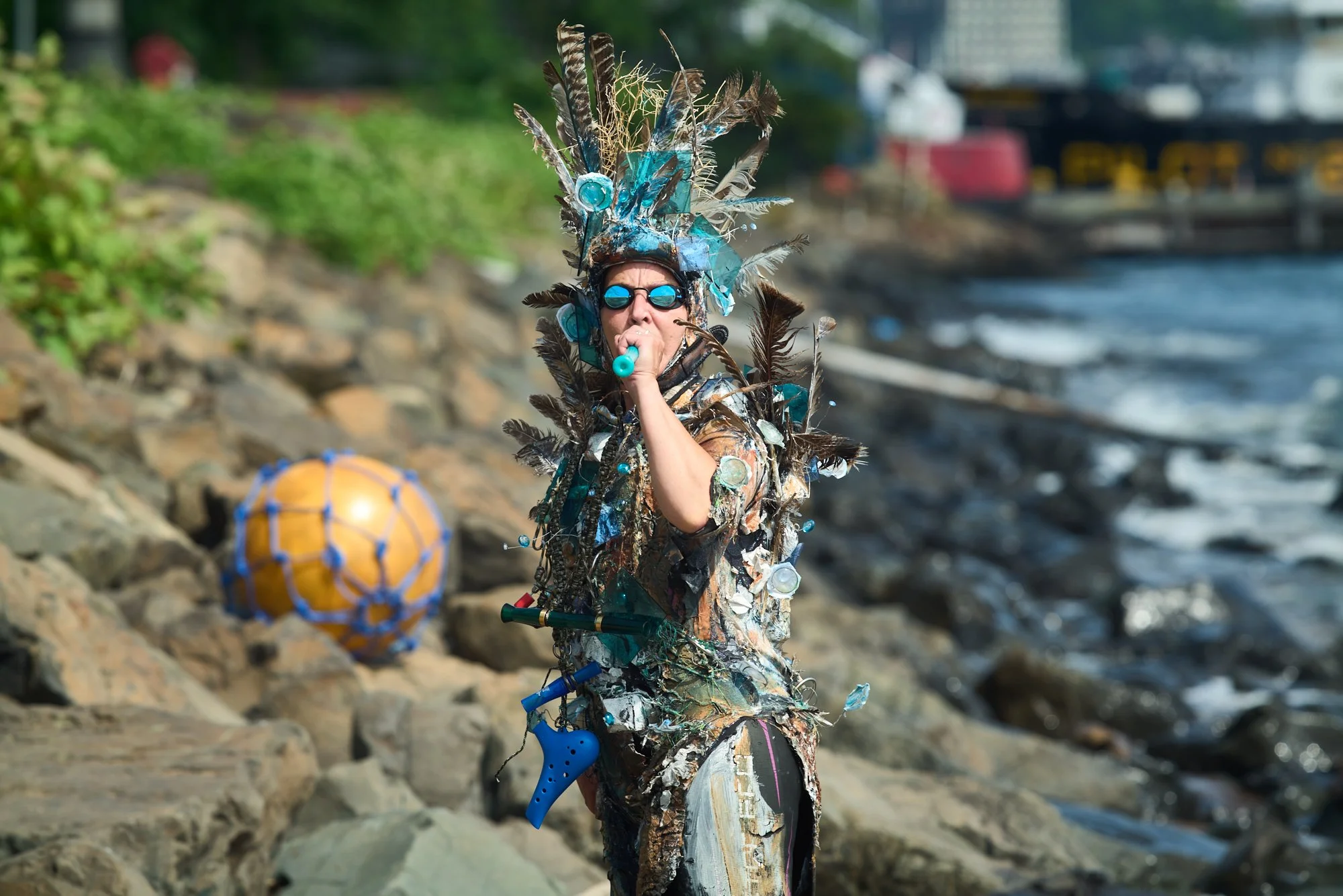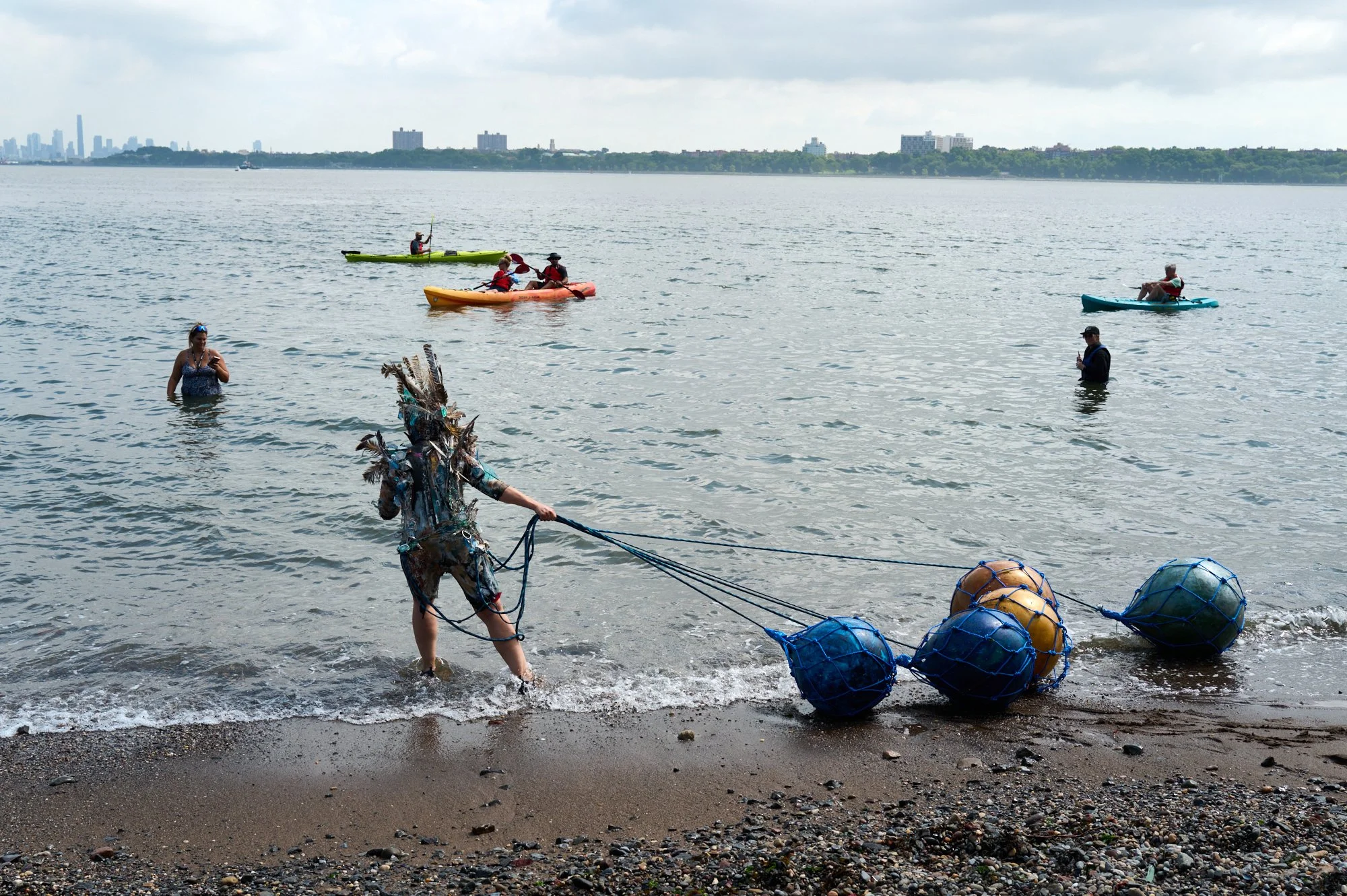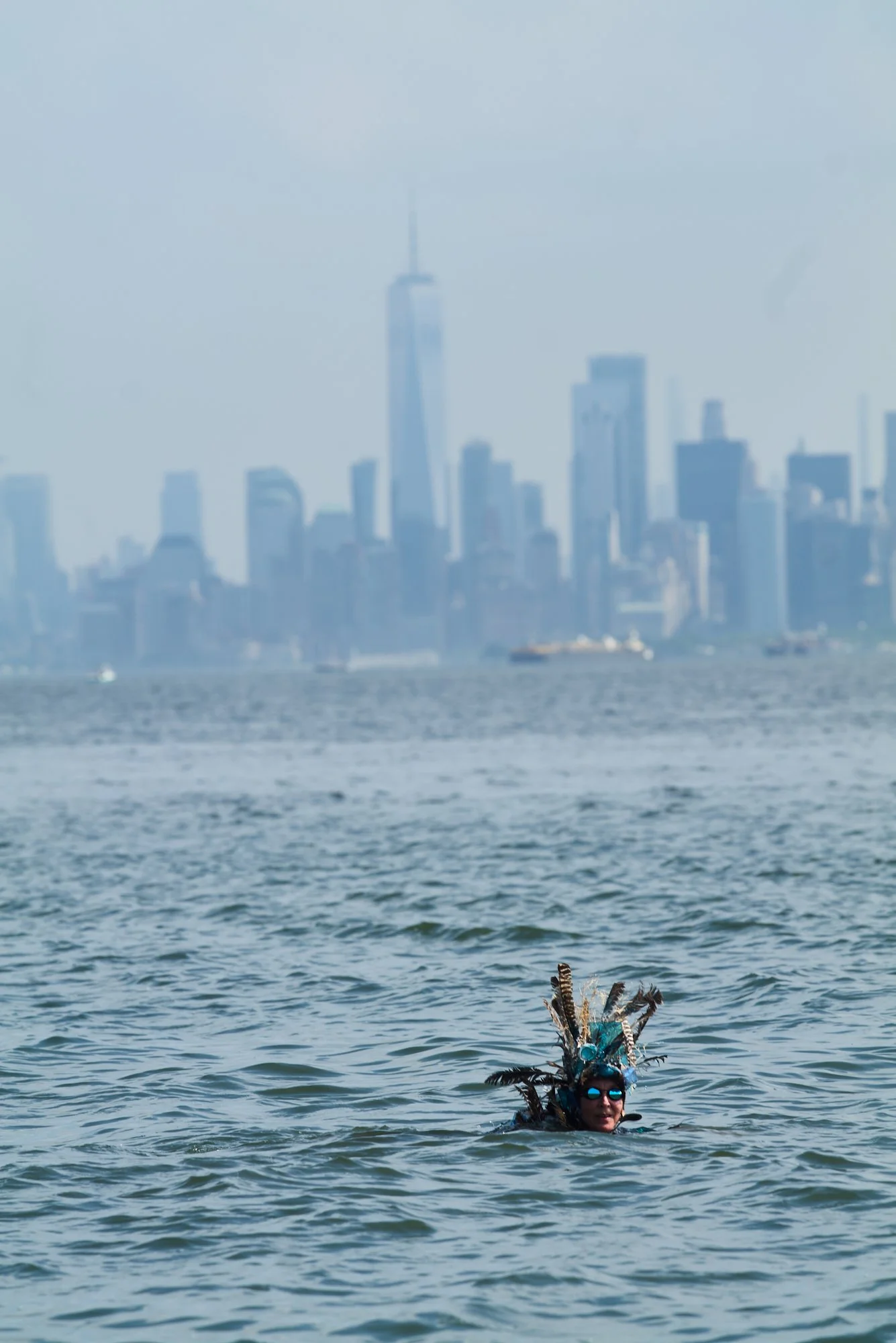Danger and Wonder Persist in DB Lampman’s Waterfowl
DB Lampman performs Waterfowl, July 12, 2025. Photo: Michael McWeeney
Local sculptor and performance artist DB Lampman takes us on a site-responsive journey that explores the movements and inner lives of beach birds.
Summer is the perfect time to reconnect with nature, spend time outdoors, and rediscover a sense of freedom while wandering through lush, overgrown landscapes. The Staten Island waterfront is varied in its wildness, with its clay cliff bluffs, rocky beaches, and sandy inlets. One could easily spend countless days afield, walking with the tide in solitude, noticing the subtle changes as the day unfolds. Yet, the beauty of nature in summer is best enjoyed with others–taking in the long, hot days, and passing time together–in communitas–in the open air.
I had one such experience recently, when, on a quiet Saturday morning, I set out early to Buono Beach. Nestled on the northeast side of the Verrazzano Bridge in the shadow of the Alice Austen House, Buono Beach is easy to miss if you're not looking for it. On the morning of July 12, however, a group of people gathered to witness a site-responsive performance by installation artist DB Lampman. Lampman, who is known for her large-scale sculptural works and performance art, presented Waterfowl, a piece that explored the movement patterns of shorebirds.
In Waterfowl, Lampman examines how humans interact with our waterways and the waterbirds that inhabit the edge of land and sea. Such birds, including gulls and geese, are particularly vulnerable to beach erosion and other impacts of climate change. The performance, which lasted about fifteen minutes and was performed twice, brought audiences closer to these species and allowed us to reflect on the role that humans play in protecting (and endangering) our shoreline.
Dressed in a wetsuit adorned with turkey and gull feathers and beach detritus, including old ropes, Lampman moved across a small stretch of rocky beach in staccato rhythms, moving in and out of sight. She'd reemerge pulling a large tethered boat buoy across the ground, which accumulated one by one, before stopping to pose and blow into a bird call necklace. The shrill bird sounds cut through the air, punctuating moments of stillness with urgency. This clamoring was further amplified by a drone buzzing around Lampman as she moved, which posed a sense of danger and wonder. The drone, operated by Lampman's partner, Scott Van Campen, both guided and disrupted the performance, which at times felt like a doomed duet.
Photo: Michael McWeeney
Lampman describes the drone as an "anonymous entity to interact with that could stand in for human activity. Surveillance, consumerism, and war are also things that drones are associated with and that impact the overall health of the planet." This element of the piece struck me. At first, it frustrated me as a viewer until its presence became a constant accompaniment, with its sounds beginning to fuse with the bird calls and the lapping of the water.
I reached out to Lampman to ask about the inspiration for this piece and how it came together. In a written statement on her website, she describes her longtime practice of open water swimming as the impetus for this project, explaining that "my goal is to create personal archetypes that highlight our relationship to the water as it sustains us on earth. I am an open-water swimmer who swims in the Atlantic Ocean on a daily basis, and one of the things I see when I swim is the high volume of damage we do to our ocean and its inhabitants through pollutants and garbage. As evidenced by our experience with Hurricane Sandy, the human impact on the world's ocean and climate change is very real and impacts us all on a daily basis. These characters make reference to a variety of cultural and historical mythologies from around the world having to do with water as the source of life."
Photo: Michael McWeeney
One of the most interesting elements of Waterfowl was the experience of witnessing the piece. I was with a group of onlookers standing on a pathway, looking down from near the Alice Austen House. Lampman was located on the beach, moving in and out of the water. The performance, which took place during City of Water Day, a regional event celebrating open access to the waterfront, took place near a group of kayakers organized by Kayak Staten Island. I spent moments watching the kayakers watch Lampman, in what felt like a meta-performance of spectatorship. My gaze kept returning to the kayakers, particularly toward the end of the piece when Lampman swam further into the water, wondering what the experience was like to witness this piece up close in the aquatic environment for which it was made. The kayaks gently shifting in the water began to take the shape of waterbirds, keeping a near and watchful eye but otherwise tending to their own existence.
Lampman's short but memorable performance blurs the lines between installation and performance, creating and playing with sculptural forms in the surrounding landscape. Leaving the beach, I felt a sense of responsibility for our role in ecological degradation, for our encroaching on habitats and endangering species. Yet, I was also renewed with a sense of community with those who gathered to experience this unique moment. After the performance, a group of us enjoyed conversation and connection, and each of us was given a small booklet to take away. The booklet, "The Waterfowl's Guide to Avoiding Danger," offers poetic, instructional text and illustrations by Lampman and serves as an artifact that will live on beyond the performance. In it, the drone is described as a signal, both welcoming and unnerving. It ends with the words, the signal is chasing/escape to the sea.
On the back page of the companion booklet, Lampman calls attention to Cornell University's 2025 State of the Birds Report, which notes that one-third of birds in the United States need conservation. It links the decline of bird populations to the destruction of their habitats, particularly in wetlands and along shorelines. It doesn't end bleakly, however. Lampman notes that shorebirds such as the American Oystercatcher are making a comeback due to the concerted efforts of researchers, scientists, and conservationists. It is up to us to heed the [bird] call to take care of our waterways.
At the heart of this performance lies a commentary on the absurdity of humanity's relationship with nature. We simultaneously are in awe of it, while degrading it every chance we get. There is a bit of humor in Lampman futilely dragging buoys across the beach into the water while a drone buzzes along, almost like the nuisance of a mosquito or fly hovering at the picnic table during a summer barbeque. There's a poignant contrast between the perceived heaviness and weight of the buoys on land and the lightness of floating in the water with them. In the last moments of the performance, we see Lampman descend into the water, swimming further away from us. The waterbird is untethered, unmoored into the dark and murky waters, no longer subject to our gaze.
Read more about Lampman’s performance as part of City of Water Day here.
To learn more about DB Lampman’s work, visit https://www.dblampman.nyc
Melissa West is a choreographer and curator based in Staten Island, NY. She is the Director & Senior Curator of the Newhouse Center for Contemporary Art at Snug Harbor, and co-founder of the Shaolin Art Party. West is dedicated to creating local opportunities and innovative cultural experiences for artists and audiences alike. mwestdances.nyc




